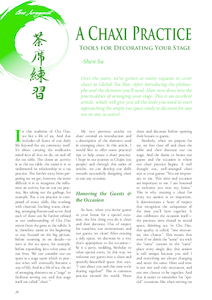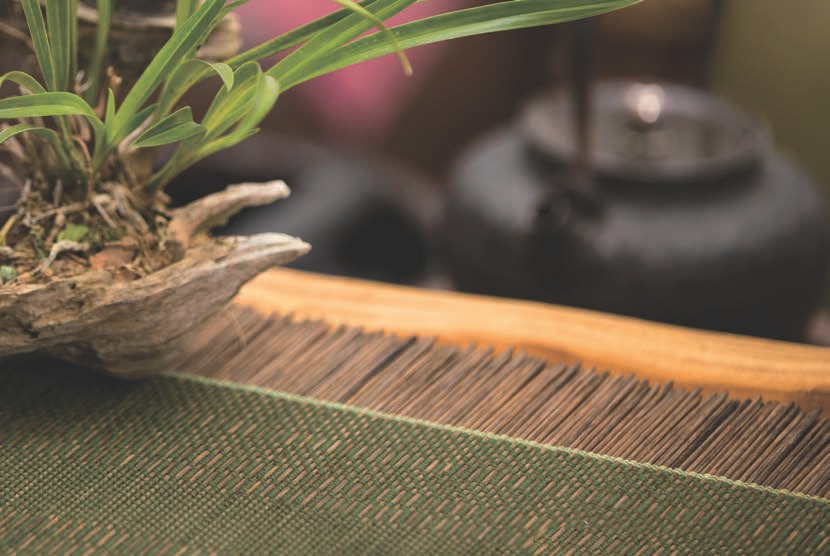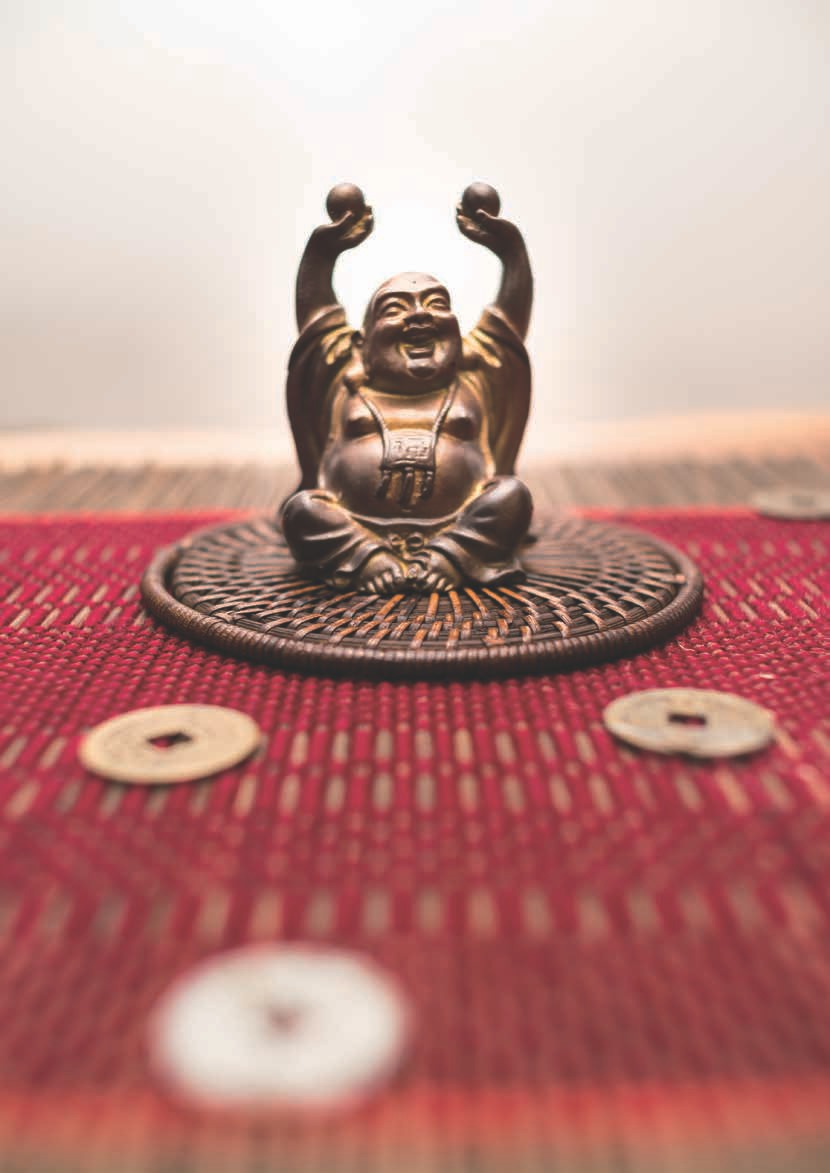
 |
|
In this tradition of Cha Dao, we live a life of tea. And that includes all facets of our daily life beyond the tea ceremony itself. It's about carrying the meditative mind into all that we do, on and off the tea table. The closer an activity is to the tea table, the easier it is to understand its relationship to a tea practice. The further away from preparing tea we get, however, the more difficult it is to recognize the influence an activity has on our tea practice, like taking out the garbage, for example. But a tea practice is comprised of many skills, like working with charcoal, fetching water, cleaning, arranging flowers and so on. And each of these can be further refined as our understanding of Cha Dao moves from the gross to the subtle. It is, therefore, easier in the beginning to stay focused on the big picture, before zooming in on details - to start at the tea space, for example, before expanding into other areas of our lives. We can consider our tea space as a stage upon which to practice what will eventually become a way of life. And in a life of tea, the art of arranging elements on a "stage" to facilitate serving tea, and that stage itself are called "chaxi."
My two previous articles on chaxi covered an introduction and a description of the elements used in arranging chaxi. In this article, I would like to offer some practical tips to help create a chaxi practice. I hope in our journey as Chajin (tea people) and through this series of articles, we can develop our skills towards successfully designing chaxi to suit any occasion.
As host, when you invite guests to your house for a special occasion, the first thing you do is clean and then decorate. Out of respect for ourselves, our environment and our guests, we clean! After creating a tidy space, we decorate in a way that's appropriate to the occasion - be it a party, wedding, birthday or other special event. In this way, we welcome our guests into a clean and specially-beautified space that says, "I care about you and this time we're sharing together!" This is common practice around the world. Hosts clean and decorate before opening their houses to guests.

"You are important to me. This time and occasion are important to me. I am honored to welcome you into my home."
Similarly, when we prepare for tea, we first clear off and clean the table and then decorate our tea stage. And the desire to honor our guests and the occasion is where our chaxi practice begins. A well thought out, well-arranged chaxi says to your guests: "You are important to me. This time and occasion are important to me. I am honored to welcome you into my home." This is why creating a chaxi for every tea session is so important. It demonstrates a heart of respect that recognizes the uniqueness of the time you'll have together. It also celebrates the occasion itself - the precious time shared in sacred space, drinking tea. In Cha Dao, this quality is called, "one encounter, one chance." This means that even if we drink the "same" tea with the "same" teaware in the "same" place every single day, this session is still unique because you and I and everything are always changing and never the same. Here and now is our one and only encounter, and our one chance to be together. And that is easier to remember for "special" occasions, like when serving tea to an old friend traveling from afar. It is all the more challenging, however, when we drink tea with someone regularly, and thus that much more important to express, especially when drinking tea with oneself! In this way, we treat every occasion as special, and they certainly are! We need a chaxi therefore to welcome guests in a way that expresses our respect for them and celebrates the fact that this will be the first and last time we drink tea together...
Tip for Honoring the Guest: One simple tip to begin setting the occasion apart is to avoid "sticky teaware!" By "sticky," I mean teaware that you are reluctant to move - teaware that has a tendency to sit around and gather dust. This might be a heavy, clunky tea sink that is not convenient to move, or a piece of teaware you always use when you lack creativity. Sticky teaware that lingers on your table stagnating betrays an over-casual air, as if to say, "Well, if you're here, I'm having tea anyway. Join me if you'd like, and if not, no worries." By arranging a new chaxi for each occasion, with your specific guests in mind, you are developing the respect that will lay the foundation for a successful chaxi practice to take root. When you care about your guests, clean your space and decorate it in their honor, then this love and care will come through your chaxi, and the tea you serve, in a way that makes them feel like this occasion is special, and like they are welcome and loved.
I have seen beautifully decorated chaxi at many tea events in which all of my attention went straight to the elegant and flashy elements of the design. The themes were obvious, but what was missing was the guest of honor - Tea Herself! This is akin to hosting a party and paying so much attention to the surfacelevel details that amidst all the lights and banners and music, you forget to invite the guest of honor! A well designed chaxi should always invite our attention towards the tea.
Your design should have a clearly defined subject and background. In other words, it should be clear from the beginning that tea is the subject. Every step in your design must stem from this understanding. All elements of your design should draw attention towards the tea. That includes the runner, tea pillow, scoop and stick, and any other element or utensil used. Tea sits at the center of the chaxi, so the elements should focus our attention on the center of the stage. Remember, chaxi can be translated as "tea stage." And like in theater, the backdrops, music, lights and other elements should draw the audience's attention to the star, not detract from her performance. Otherwise, Tea becomes lost among the elements, without the due respect She deserves. It is, after all, a tea ceremony, so we must keep our priorities straight and remember for whom we're throwing the party!

In order to design a successful chaxi you must understand the occasion. Who's attending your session and how many guests are there? How are they feeling and what tea will suit them? What season is it? What's the weather like? What time of day is it? All of these questions and more should go into designing your chaxi. Intuition is also important, but in the beginning, stick to the functional questions first. When you understand the practicalities of the occasion, you will be able to choose a suitable tea, the appropriate brewing method, and design your chaxi accordingly.
It is important to focus first on function and then form. A chaxi that looks beautiful but doesn't function well is like a fine teapot that delights the eye but doesn't handle nicely when brewing tea. The ideal is almost always a chaxi that is functional and beautiful, like food that is both nutritious and delicious. In the beginning, focusing on function first will be very helpful. Get the basics down and don't let your creativity get in the way of the session that's trying to unfold. This is not to say don't express yourself creatively, but rather remember that anything which draws attention to you is drawing attention away from the guest of honor, which is worth repeating throughout this discussion: Tea Herself!
Knowing which brewing method you will use makes a big difference in your chaxi design. Chaxi for gongfu tea, while not lacking in beauty, is often more contained around the brewer and is designed, like this method itself, to make the best cup of tea possible, which means it will naturally be a more function-oriented arrangement. Traditionally, gongfu tea was reserved for smaller parties of up to five people, which meant a smaller tea space. Therefore, additional elements quickly became unnecessary and only the essentials remained. When designing a chaxi for gongfu tea, stick with the necessary tools to brew the finest cup of tea possible, and then refine and highlight with decoration. Oftentimes, the essential elements themselves can be decorative, like choosing a fine wastewater basin, for example.

Tip for Keeping Tea as the Focus: Your design should be simple. Less is more! My teacher almost always takes something away from my "completed" chaxi. If adding an element to your design doesn't absolutely offer an enhancement in form and/or function, as well as draw attention towards the subject, then it's probably superfluous. There are no neutral elements in a chaxi. If you feel it's neutral, then it is most likely detracting from the subject. Remove it. Simplify. Do so until your chaxi expresses what it needs to with as few elements as possible.
Chaxi for bowl tea, on the other hand, while not lacking in function, may appear to be more aesthetic in its design, which is appropriate for the purpose of the method: to share tea as medicine with sacred intention in ceremony. It's therefore easier to make the mistake of letting aesthetics override function, but the function should be well-integrated into the design of this kind of chaxi as well.
Bowl tea is appropriate for both large and small tea sessions, so utilizing space for function and form becomes more of a challenge. A chaxi for ten people is quite different than one for three. Knowing how many guests there will be plays a large role in the functional elements that will guide in the arrangement of a chaxi for this kind of ceremony.
Tip to Not Forget Function: In general, keep chaxi for larger gatherings simpler and lower to the table, with fewer elements that might easily become obstacles when serving so many people - obstacles to the one brewing, who will have to navigate them when handing out and collecting the many bowls, and obstacles to your guests' attention. When designing a chaxi for bowl tea, I always sit at the brewer's seat first to see how it feels functionally, and then stand back to see how it looks and feels from the guests' perspective.
This is where your creativity can finally come into play! What is it that you want to express? It helps to keep your themes general in the beginning and then work towards more refined, specific themes as you get better at arranging chaxi. Obvious themes can be based around certain events, like Chinese New Year, anniversaries, birthdays, etc. You could also theme your chaxi as an offering to your highest self, or a friend or family member far away, setting aside an extra bowl or cup of tea for the person in mind. The possibilities are limitless...
You can think about your chaxi as a mandala: a piece of art connecting this brief moment in time to the entire universe. This can be achieved by using symbolic elements in your design. For example, a small statue of the Buddha, a vajra (a symbol of spiritual power), a red or gold runner or a sutra, just to name a few, are powerful images, symbols and colors that express a lot of meaning. Use them wisely, for the right occasion and in conjunction with tea - never at its expense!
There are many ways to theme your chaxi around Nature, the season or the weather. For example, strive to make your guests feel cool in the summer. A small water feature might be used to this end, or a blue runner that could symbolize a cool river. In the cooler months, you can create a warm ambiance by using certain colors, like orange and red, and/or arranging the elements in a tighter configuration. There are always seasonal elements, often just out your front door, that you can bring into your design to bridge the boundary between inside and outside, Nature and Tea. Flowers, greenery, rocks, moss, leaves and more can all be brought inside to connect us to Nature.
If you really want to improve your chaxi, then you have to get started designing and arranging them, which, of course, means hosting more tea gatherings and serving more tea in general! Find the motivation and inspiration you need, and practice arranging many different chaxi arrangements. There is something called the creative gap that you want to close! This gap is the difference between what you envision and what you can actually create. In order to close that gap, you need to practice consistently and often, until what you see in your heart meets what you create in your tea space. Most important will be to remember the four key points we covered in this article: Honor your guests and the occasion, remember the guest of honor is Tea, design with function first followed by form, and finally, choose and express a theme that suits the occasion.
練 習 成 就 完 美

Tip for Your Theme: In bowl tea, some elements, like the bowls, tray for bowls (if you use one), or teapot, for example, will be used during the tea session but won't be part of your chaxi. It's often better to leave your chaxi as bare as possible for when the guests arrive, suggesting the tea to them, inviting them onwards. This is like when the guest of honor makes a grand entrance at her party. By leaving the teaware off the stage until all the guests area seated, the tea will have a more defined beginning. Let your guests sit at the table and enjoy what you have created for them. Once the water for tea is ready and the feeling is right, slowly and carefully add these other elements for the actual brewing of tea to commence. Usually a chatong (tea helper) will aid in this process. This doesn't mean the teapot can't be used in the design of your chaxi as a centerpiece; it will often be so. The bowls and tray for bowls will almost always come out after the water is ready, once your guests have had some time to sit and appreciate the tea stage; but they can also be used successfully in a stunning chaxi.